Shaun Azzopardi met up with a team of researchers led by Eur. Ing. Charles Yousif to take the concrete block to the next level. It is more exciting than it sounds. Photography by Dr Edward Duca.
Buildings use the majority of a country’s power. A big chunk of this energy need goes towards controlling its inside temperature. Malta does not suffer extreme temperature swings, the sea keeps everything cooler in summer and hotter in winter. Beijing, for example, experiences temperature swings of around 40˚C every year, and Helsinki 60˚C.
Despite mild temperatures, Malta’s temperature extremes are still high or low enough to make us uncomfortable. This means that heaters dominate winter, while air conditioners are switched on in summer. Energy demands are heavy all year round. Reducing the need for these energy hogs would go a long way towards helping Malta reduce its carbon footprint, at the same time reducing costs. At the University of Malta, a team headed by Eur. Ing. Charles Yousif in collaboration with Prof. Spiridione Buhagiar are working with industry to do just this by developing better building blocks.
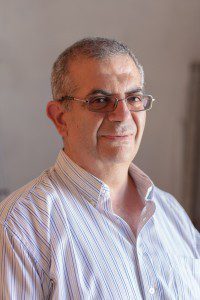
Yousif’s Postgraduate student, Perit Caroline Caruana, is working on making better concrete blocks. The project is called ThermHCB to refer to the anticipated end product, a more thermally efficient hollow concrete block (HCB). The academics are collaborating with block manufacturer R.A. & Sons Manufacturing Ltd. and project leaders Galea Curmi Engineering Services Ltd, while being funded by the Malta Council for Science and Technology (MCST). I visited Caroline at the University’s well-hidden Institute for Sustainable Energy in Marsaxlokk to learn more about this project.
Limestone is Malta’s traditional construction material, but due to dwindling supplies hollow concrete blocks are being widely used. A mixture of specific proportions of sand, cement, aggregate and water is moulded into blocks (roughly a cuboid with two large holes). Briefly, the project involves playing around with these proportions, and introducing new materials into the mix, to achieve a better block. But what makes a better block?
ThermHCB aims to produce a hollow block that has ‘the same size, the same hole dimensions, such that both the builders and the public, who are the ones using it at the end of the day, will not find it difficult to adapt to’. A better block would therefore simply have the same strength properties of a normal one, with the difference of allowing less heat transfer between both the inside and the outer surfaces. In winter less heat would escape a building, while in summer less heat will seep into a building.
Changing the block’s shape was not an option. ‘We couldn’t’, said Caroline, ‘if the manufacturer has to change the design of the block he would also need to change the [whole] production line’. For this reason, she is focusing on how to change the proportions of the constituents and introduce new materials to maintain the standard properties while improving the thermal (heat/cold-related) characteristics.
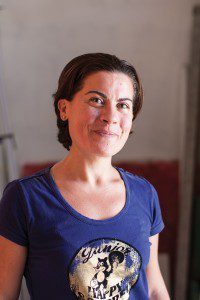
A basic property that must be maintained is the compressive strength of the normal block, which measures its load-bearing capability. Since buildings need to stay up, the load-bearing capacity cannot be compromised as it would make the block unusable for that purpose. Its only use would be internal partitions which do little to insulate houses.
Caroline is an architect by trade. She finished her first degree in architecture in 2000 and worked for many years with a local company. She explained how attuned she is to the needs of industry, ‘I have always been interested in energy, […] my dissertation for my degree was about energy in buildings with the Institute [for Sustainable Energy]’. She did not immediately start a postgraduate course and instead obtained some hands on experience through industrial work. This allowed her to tap into how industry operated, making her ideal in this collaborative project with such wide industrial potential.
In the backyard of the Institute, I had the chance to see two small rooms shaded by some green netting. Caroline and the team built these rooms as prototypes for testing ThermHCB hollow cement blocks.
The Institute could not build these test rooms without vital industrial partnerships. This is where R.A. & Sons Manufacturing Ltd., a local concrete block manufacturer, comes into play. Since ThermHCB blocks use the same standard shape of locally available HCBs, the researchers could use the company’s production line to manufacture the expected thermally improved blocks. In a typical experiment, enough blocks are created to build a wall, which is then tested by both the Institute and Galea Curmi Ltd., using different methods.
At the Institute, thermal testing is carried out to measure the transfer of heat through the blocks. The technique applied is called the heat flow meter method, which incorporates the use of heat flux sensors and thermocouples (a type of heat sensor) placed on the internal and external surfaces of the blocks making up the test walls.. The heat flux sensors measure the rate of heat transfer between inside the room and outside. From this data the U-value of the block is computed; a value that indicates the thermal conductivity of a wall. In other words, the bigger the U-value, the faster the heat flows. The project is pushing for a smaller U-value that would better insulate houses.
“In winter less heat would escape a building, while in summer less heat will seep into a building”
The prototype wall is first built in situ. This allows for valuable data that reflects accurately how the blocks perform when used in real world conditions outside. Caroline explains how she gathers data for at least a week before analysis is carried out. This reduces data errors emancipated through fluctuations between day and night.
Solely relying on real-world data is problematic. The weather plays an important role because the higher the temperature difference between the two sides of the wall, the higher the U-value calculated. The U-value varies: it is not a constant even for the same material. Thus the same wall (taken down and rebuilt exactly) is also tested in a controlled space, where the temperatures on either side of the wall are controlled. The wall is placed inside a hot box. ‘The values gathered from the in situ setup [the ones from the external hot box] are very well correlated’ according to Caroline, which she says is a good sign and helps confirm that the real world testing is correct.
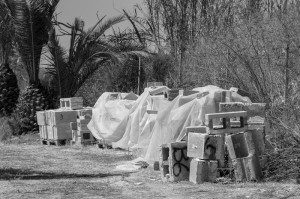 This hot box was purpose-built for this project according to international standards, however it means much more for the Institute. Yousif explained how they ‘can use it to test other products of different industries. It can be insulation material, a wall [and] anything which has to do with buildings’ and they want to use it to ‘further our collaboration with industry’. So this project has already borne some fruits for the Institute. They have already used it to test insulation material for a private company.
This hot box was purpose-built for this project according to international standards, however it means much more for the Institute. Yousif explained how they ‘can use it to test other products of different industries. It can be insulation material, a wall [and] anything which has to do with buildings’ and they want to use it to ‘further our collaboration with industry’. So this project has already borne some fruits for the Institute. They have already used it to test insulation material for a private company.
Getting the methodology of the experiment just right was not always easy, especially when summer started, explained Caroline. An important aspect for data gathering was to try and keep the temperature difference between inside and outside at least 10˚C, but the Maltese summer sun was too strong, increasing the possibility of experimental errors. Polycarbonate sheeting, air conditioners and fans were all used in different ways to try to alter the temperature difference, however they proved unsuccessful. They finally settled on a green netting, shading the test walls. This simple measure succeeded in reducing errors from minor temperature differences. Getting the methodology right at first go is not easy (or normal), as some unexpected problems always crop up. In many cases, it is hard to find solutions to such problems simply by reading through publications or books; it has to happen through trial and error—the approach of this team.
The other test performed by Galea Curmi Ltd. on the concrete blocks is the infrared method. For this test, the infrared radiation from the inside of the test wall is measured. Infrared is the wavelength of light at which most heat emitted from objects, including from us, travels. By detecting infrared radiation the industrial researchers can pin down the level of block heat transfer. Caroline explained that values gathered from using this method varied from the heat flow meter method. The infrared method is newer and the procedure is still in draft ISO standard mode—it has not been made uniform. It is not as reliable as the heat flow method but scientists see a potential in this method since it is faster and can be carried out in situ, practically anywhere.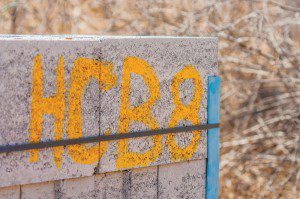
The project first tested three prototype blocks. The best performing block improved the U-value, lowering it by 8%. The block was a better insulator. This value does not give the whole picture; compressive strength must not be compromised. It is useless to have a good insulating block that cannot keep a building up. Compressive strength tests were carried out under the direction of Prof. Spiridione Buhagiar (Faculty of the Built Environment) that showed that this prototype block had appropriate compressive strengths. From these first results another three mixes were created and are currently being tested.
If this project is successful, the block will be a step closer to reaching the market. This requires further investigation. Research takes time. ‘It is not enough to test the material against compressive strength, you want to [also] see lateral strength, […] how it changes with humidity levels, what happens when it gets wet, [its] fire rating, acoustics […]’, explained Charles. The part he is least worried about is ‘the marketing stage, because once you have passed all the tests it is only a matter of advertising it and using it to construct two or three buildings, and people will latch on to the idea’. The block is likely to be more expensive when launched. Government support is needed through financial grants and tax rebates, similar to solar heaters and solar photovoltaic panels. ThermHCB can contribute towards Malta’s binding targets to increase energy efficiency by 22% by 2020.
Charles wants to attract more people like Caroline (he calls them ‘old graduates’), who have experience in industry, to University. ‘I think we need to open up University’s doors to all graduates and reach out to industry. This requires collective effort from all entities both within university and outside it.’ He feels that there is a big gap in the knowledge of graduates who obtained their degree some time ago; they have little time to learn about new products. He talked about double-glazed glass windows, which his Ph.D. research has shown does not improve energy efficiency significantly in residential buildings, yet grants are being given out to encourage people to do just that. Even though, ‘if the same amount [is given] to insulate walls […] for the same amount, or a bit more, [one] can achieve more energy savings’. Highly efficient building blocks and wall insulation are not being financially supported.
The Institute is performing other research to try and create zero-energy buildings. A recent study investigated how this reduction in energy use can be made in a cost-optimal manner. Charles explains cost-optimal as ‘the least painful way of achieving a better building standard’. By painful, he refers to the best value for money when trying to reduce energy use, such as walls, roof insulation, or using solar water heaters. The Institute’s studies have been presented to the relevant ministries and energy agencies to provide them with the expert knowledge needed for government to catch up on its energy reduction obligations set by the EU.
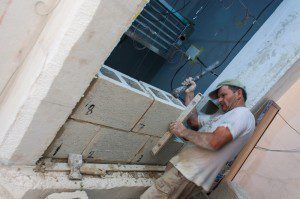 ‘We have to achieve 22% energy efficiency by 2020, besides the other mandate of having 10% renewable energy by 2020 […] and therefore we need to think not only about solar panels, solar heaters, and renewables in general, but also on how to improve the building fabric, how to address the issue of energy consumption in buildings, space heating and cooling, and also water heating.’ The Institute is working on all these fronts. It is collaborating with Ferrara University in Italy and Valladolid University in Spain, to kick-start a project to improve space heating and cooling. This project differs from ThermHCB since ThermHCB cannot be used on current buildings. The other project uses shallow ground around existing buildings (such as a walkway or pavement), to store energy to heat or cool an entire building. Existing buildings in Malta and elsewhere could be revolutionised, without having to go too deep underground.
‘We have to achieve 22% energy efficiency by 2020, besides the other mandate of having 10% renewable energy by 2020 […] and therefore we need to think not only about solar panels, solar heaters, and renewables in general, but also on how to improve the building fabric, how to address the issue of energy consumption in buildings, space heating and cooling, and also water heating.’ The Institute is working on all these fronts. It is collaborating with Ferrara University in Italy and Valladolid University in Spain, to kick-start a project to improve space heating and cooling. This project differs from ThermHCB since ThermHCB cannot be used on current buildings. The other project uses shallow ground around existing buildings (such as a walkway or pavement), to store energy to heat or cool an entire building. Existing buildings in Malta and elsewhere could be revolutionised, without having to go too deep underground.
Many exciting projects are being carried out in the name of sustainable energy, ensuring that some solutions to our energy problems will be found. By involving industry, these solutions could be applied to reach the market and end-user. That is the only way the findings of these projects will actually be used. This provides hope that ThermHCB, once fully developed, will not be difficult to bring to the market. Charles is confident that ‘definitely by 2020’ we will have ThermHCB-built buildings. I hope that will be around the time I will start building my first home.

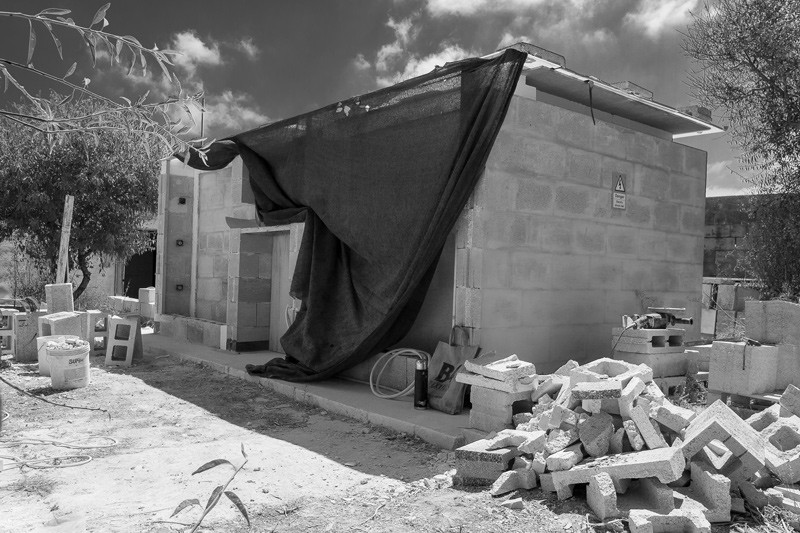




Comments are closed for this article!